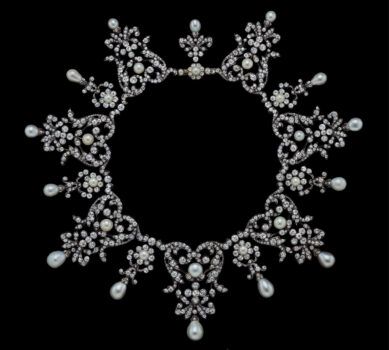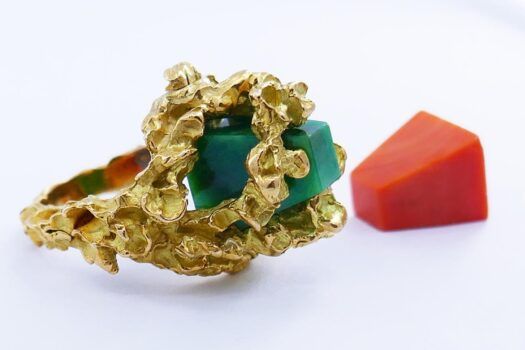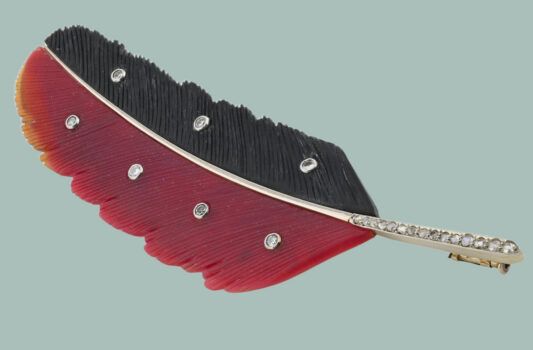So many summer jewelry “don’ts” happening here. Trunk Food 05 by Miles Aldridge, 2007; offered by Grimaldi Gavin.
Most of summer’s sartorial decisions are pretty intuitive. You swap seersucker for wool and linen for leather. Sandals sub in for snow boots, and swimwear for skiwear. But — what do you do with jewelry when the season changes?
We posed this question to blogger and jewelry designer Carissa Stevens of Scout Studios. Turns out, the most important thing to think about in regards to summertime jewelry is how to care for your baubles during the warm weather months. If not properly managed, sun, sand and salt can really take their toll on metals and stones. In order to avoid a scenario in which your otherwise perfect beach day is ruined by an (expensive) jewelry mishap, we asked Stevens for her tips on summer jewelry care and how to keep your gems sparkling all summer long.
Swim, Sun and Surf:
- If possible, avoid contact between jewelry and chlorine completely. Chlorine (and other chemicals and minerals frequently used in pools) can change the sheen or finish on your gems. And over time, they can cause more serious corrosion that contributes to the breakdown of precious metals and stones.
- If contact with the elements or chlorine cannot be avoided, always rinse jewelry post-swim with fresh, lukewarm water. Mild detergent soap or ammonia may be added too.
- Chlorine isn’t the only thing to keep away from your most precious gems — saltwater can be just as damaging. Salt is corrosive to copper, which means exposure to rose gold is a big no-no. It can also be absorbed by softer stones (like coral or turquoise), which causes them to rot from the inside out. If you can’t bear the thought of going to the beach bauble-less, stick to sturdy platinum or yellow gold. The brass and silver in yellow gold help make it more resilient.
- More of a sunbather? You’re not exempt. Sand — which is comprised of silica, the same substance used to make glass — can cause scratching and abrasions on metals and stones. Remember to remove rings and any other jewelry that will come in contact with sand as it can scratch metals and cause wear and tear too.
- Sweat plus metal isn’t a good combination — sterling silver, for example, can turn black via prolonged exposure to natural body oils.
- One final PSA: cold water will make your fingers shrink. So no precious rings near the ocean, please!
Storage and travel:
- Prevention is the best cure. If you’re planning to travel this season, do yourself a favor and invest in a travel case with distinct compartments to prevent baubles from scratching one another during transport.
- Each precious metal or stone is unique and has different storage or cleaning requirements. Pieces containing the June birthstone, pearls, for example, should be stored in cloth rather than plastic to allow them to breathe. Diamonds are the hardest gemstone in the world and when loose, should be stored separately from other gemstones.
- Store silver pieces in airtight plastic bags. Some jewelers suggest adding a piece of chalk which is thought to absorb some of the airborne chemicals that can cause tarnish. Most other metals require a “breathable” environment in order to prevent oxidation.
- Excessive exposure to harsh light sources and temperatures (i.e. sunlight, UV lamps, etc.) should be avoided. Certain gemstones can actually crack when exposed to extreme heat. This means not leaving pieces in a hot car, or in a handbag while sunbathing.
Creams, Sprays and Lotions:
- Don’t worry too much about getting sunscreen on your jewelry. Since it is gentle enough to put on skin, it won’t cause long-term damage to metal or stones. However, sunscreen can compromise the integrity of string or thread — so be mindful of strung jewelry like pearls or beads.
- Always remove jewels before applying lotions or creams —over time, they can build up a film on your jewels and leave them looking lackluster or dull. Don’t put them back on until the skin is completely dry and the product has absorbed into the skin.
- Traditional insect repellents that utilize chemicals like DEET are bad news for metals and stones alike. Stick to a biodegradable option — like this one from the Honest Company — or eschew jewelry if you know it will be buggy.
Cleaning:
- Always use a soft polishing cloth when drying off jewels, and never use tissue or paper towels. Even a bath towel can be abrasive on fine jewelry, as mountings or settings can get caught in the tiny loops and cause them to loosen.
- Before using a cleaning solution, speak with a jeweler about the most appropriate method for your piece. Some metals and gemstones can react differently to particular solutions.
- As a rule of thumb, taking fine jewelry to the jeweler for a professional cleaning — once a season — is always a good idea. Not only will they come back looking (and sparkling) like new, but this also gives the jeweler the opportunity to check that all mountings and settings are secure and haven’t loosened from summer fun.





